Advertisements
Advertisements
प्रश्न
Draw a neat diagram of a solenoid and name its various components.
उत्तर
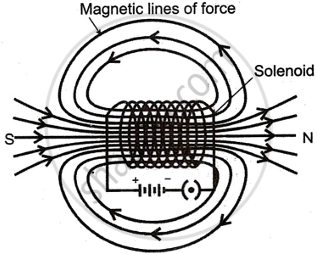
APPEARS IN
संबंधित प्रश्न
Why does a current carrying, freely suspended solenoid rest along a particular direction?
State the direction in which current-carrying freely suspended solenoid rests
Draw a diagram to represent the magnetic field lines along the axis of a current carrying solenoid. Mark arrows to show the direction of current in the solenoid and the direction of magnetic field lines.
The adjacent diagram shows a small magnet placed near a solenoid AB. Current is switched on in the solenoid by pressing the key K.
- State the polarity at the ends A and B.
- Will the magnet be attracted or repelled? Give a reason for your answer.

What effect will there be on a magnetic compass when it is brought near a current carrying solenoid?
A current carrying solenoid behaves like a ______.
- What name is given to a cylindrical coil of diameter less than its length?
- If a piece of soft iron is placed inside the coil mentioned in part (a) and current is passed in the coil from a battery, what name is then given to the device so obtained?
- Give one use of the device mentioned in part (b).
Draw the pattern of magnetic field lines of a solenoid through which a steady current flows. What does the pattern of field lines inside the solenoid indicate?
Draw magnetic field lines in and around a current-carrying straight solenoid.
The diagram shows a current-carrying coil passing through a cardboard sheet. Draw three magnetic lines of force on the board.
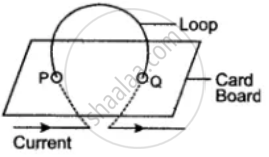
State two factors on which magnitude of magnetic field at the centre depends.
Sketch the lines of force of the magnetic field of a solenoid. How does its field compare with that of a bar magnet?
The adjacent diagram shows a small magnet placed near a solenoid. State whether the magnet is attracted or repelled, as the switch is pressed. Give a reason.
What is a solenoid? Why do we usually keep its diameter small in comparison to its length?
The magnetic field lines outside a bar magnet:
The factors on which one magnetic field strength is produced by current-carrying solenoids depends are
For a current in a long straight solenoid, N-pole and S-pole are created at the two ends. Among the following statements, the incorrect statement is ____________.
The diagram below shows a magnet moved near a coil along its axis. Which of the diagram shows correct flow of current during this motion?
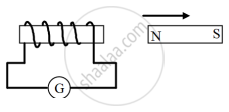
Under what conditions permanent electromagnet is obtained if a current carrying solenoid is used? Support your answer with the help of a labelled circuit diagram.
What does the divergence of magnetic field lines near the ends of a current carrying straight solenoid indicate?
The diagram below shows an insulated copper wire wound around a hollow cardboard cylindrical tube. Answer the questions that follow:
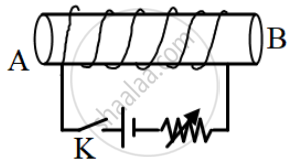
- What are the magnetic poles at A and B when the key K is closed?
- State two ways to increase the strength of the magnetic field in this coil without changing the coil.
- If we place a soft iron bar at the centre of the hollow cardboard and replace the DC source with an AC source then will it attract small iron pins toward itself when the current is flowing through the coil?
A circuit contains a battery, a variable resistor and a solenoid. The figure below shows the magnetic field pattern produced by the current in the solenoid.

- State how the magnetic field pattern indicates regions where the magnetic field is stronger.
- What happens to the magnetic field when the current in the circuit is reversed?
Ansari Sir was demonstrating an experiment in his class with the setup as shown in the figure below.

A magnet is attached to a spring. The magnet can go in and out of the stationary coil. He lifted the Magnet and released it to make it oscillate through the coil.
Based on your understanding of the phenomenon, answer the following question.
Is there any difference in the observations in the galvanometer when the Magnet swings in and then out of the stationary coil? Justify your answer.
Observe the given figure of a current-carrying solenoid and write the labels of A and B correctly.
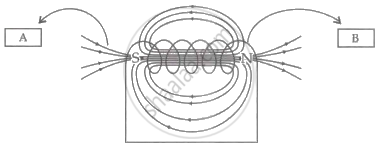
When does a solenoid behave as a magnet? Draw the pattern of the magnetic field produced inside it showing the directions of the magnetic field lines.
Refer to the image below and state how the magnetic field pattern indicates regions where the magnetic field is stronger outside the magnet. What happens to the magnetic field when the current in the circuit is reversed?
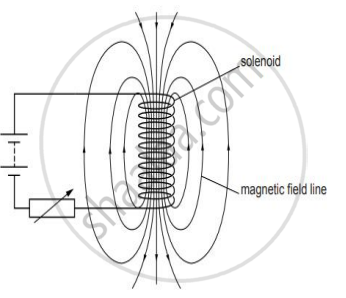
How is a solenoid prepared?
Differentiate between a circular coil and a solenoid.
Current is flowing through a coil as shown in the figure. Which one of the given figures will correctly depict the magnetic polarity and the direction of the lines of force along the axis of the coil?

